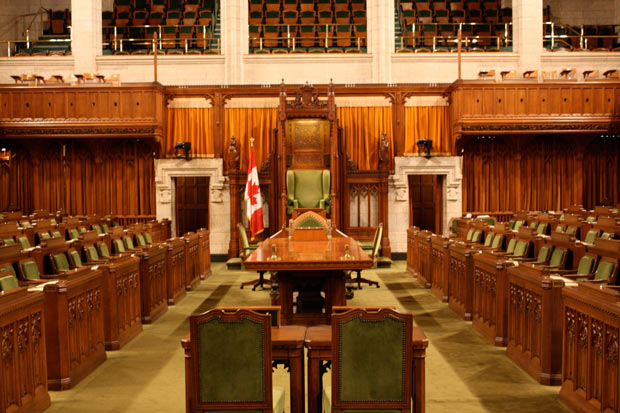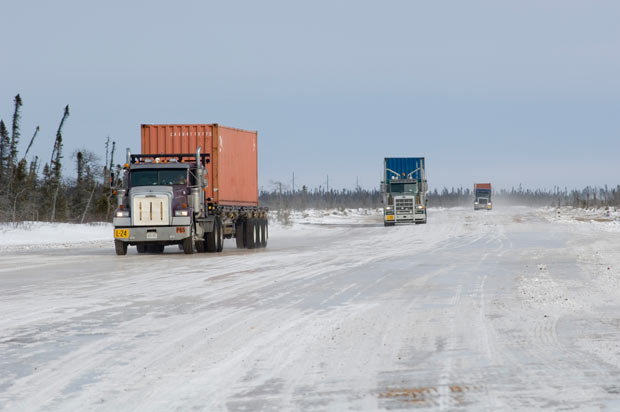
THUNDER BAY – Politics – Minister Tony Clement was in Thunder Bay on Tuesday. At a luncheon address at the Da Vinci Centre to an audience from the Thunder Bay Chamber of Commerce, Minister Clement outlined the direction the Conservative Government are taking.
Minister Tony Clement – Chamber of Commerce Speech
It’s great to be back in Thunder Bay. These are truly exciting times for the city and the region.
There is a buzz in the air and a sense of dynamism that, as Minister for FedNor and someone who has been criss-crossing Northern Ontario since 2006, gives me great satisfaction.
I just came from an announcement at the Thunder BayAirport which exemplifies this energy and optimism.
As many of you know the Thunder Bay Airport Authority has gone above and beyond the call of your run-of-the-mill airport manager.
It has aggressively expanded beyond its local market and its original mandate: it manages and offers consulting services to other airports, it sells – I should say exports – aviation software services across North America and the Caribbean, and it’s the exclusive distributor for a Swiss manufacturer of airport service maintenance equipment.
And when it comes to its core business, Thunder Bay has distinguished itself. It is one of the lowest cost airports in North America. Not surprisingly, passenger traffic hit an all-time record of 761,000 travelers in 2012.
And the airport is well-positioned to see volumes increase: I understand last week United Airlines began daily flights to and from Chicago.
I was at the airport this morning announcing $1.5-million in FedNor funding to support the expansion of its industrial park, which has already filled to capacity.
I am proud of our Government’s support for great innovators like the Thunder Bay Airport Authority, but I think it’s important to take some time to talk about its accomplishments.
Why? Because it’s a great example of not only what is possible in Thunder Bay, but what is indeed happening across the city and in a range of sectors.
What’s happening at the airport is not an isolated success story. If anything, the record traffic and the new flights are a reflection of the new business taking off (excuse the pun) in the region.
Today at the airport, for example our Government also announced $680,000 in repayable contributions to two innovative local companies.
Qwan Technologies Inc. is fast becoming a “go to” company for data integration in the mining sector in North America and XLV Diagnostics Inc. is a medical equipment company which is developing a low-cost, digital mammography device.
Then there’s the Bombardier factory, which continues to be on track with high-value jobs for this city, and Lakehead Marine and Industrial Inc. which is diversifying into engineering services and industrial cranes.
And let’s not forget the growing health sciences and bio-technology cluster, anchored by the Thunder Bay Regional Research Institute.
This cluster is not only developing home-grown talents, but attracting some of the world’s brightest minds to the region.
FedNor is supporting this cluster with a $4 million investment for the cyclotron, which will produce medical isotopes for medical research and the development of new medical devices – producing a ‘healthy’ revenue stream for the Institute.
When you go through the list of everything that’s happening, it’s no wonder that construction starts are up and that there are cranes –always a good sign of a healthy economy – around the city.
And I haven’t even mentioned mining and the dozen or so projects in various stages of exploration and planning.
It’s no surprise then that the Conference Board of Canada came out just this past Friday with a pretty rosy assessment of Thunder Bay’s prospects.
For the first time since 2000, the city has enjoyed two consecutive years of positive growth. Something the Conference Board calls “remarkable.”
The Board also forecast two more years of positive GDP to 2014.
I don’t know about you, but I would like to be a bit more ambitious than two more good years.
And I think the opportunity is there, thanks to the innovation and drive demonstrated by the Thunder BayAirport and all the companies I just mentioned.
And there’s another opportunity. A generational opportunity. I am talking about the Ring of Fire development.
As many of you know the Ring of Fire is potentially the biggest mining development Northern Ontario has ever seen. And that is saying something.
It is estimated to contain between $30 to $50 billion worth of minerals – enough to be mined for several decades.
Let me repeat that: mining for several decades.
Its chromite deposits represent the single, largest, stable source of the metal in North America.
The Ring of Fire has the potential to create over 5,000 direct and indirect jobs in Northern Ontario alone, plus significant spinoff benefits throughout the province.
I don’t believe this is an opportunity we can afford to let pass us by.
Which is why the Prime Minister asked me to coordinate and lead our Government’s engagement on this file.
The Ring of Fire is no ordinary mine development. It is a unique platform from which to materially improve the quality of life for thousands. It will ensure Northern Ontario’s rich mining legacy continues far into future. And the ripple effect from the wealth it generates will be felt far beyond the Ring itself and even Ontario.
There is a lot at stake and we cannot afford to allow this development to stall and become mired in paralysis and uncertainty.
There are many stakeholders – communities, First Nations, private industry, different levels of government and ordinary citizens. It is complex, there is no doubt about it. But that is not a reason to shrug your shoulders and walk away.
What it means is that we have to make the extra effort. All of us. From our Government’s perspective, I believe it is incumbent upon us to bring a whole of government approach to this process.
And that will be part of my job in this role. I will work in coordination with my colleagues at Aboriginal Affairs, Industry, Natural Resources, Environment, Finance, Health, Human Resources, and Transport, Infrastructure and Communities, to ensure we speak with a single voice when we dialogue.
And engaging other partners will be critical to what I do. It’s time to push the refresh button on this opportunity. That means reaching out to all key stakeholders to ensure that this development moves forward to the benefit of everyone.
Let me say it again: Northern Ontario has a once in a generation opportunity to generate jobs, growth and long-term prosperity with the Ring of Fire.
Much of Canada’s wealth was founded on mining. And much of its future prosperity will be too. We should not fritter it away.
We need to do this right. But we need to do this.
And as FedNor’s longest serving Minister I will do my best to help make it happen.
Red Tape Reduction Action Plan
Now, to switch gears a little. There are a lot things our Government is making happen to support jobs, growth and long-term prosperity.
And one of those things, in fact one of the most important things government can do to support Canadian business is to cut red tape.
Prime Minister Stephen Harper describes red tape as a “hidden tax” that stymies ambition and suffocates innovation. In today’s competitive world, it’s a burden Canadian companies simply can’t afford to carry.
That is why we are making a concerted effort to lighten the load.
In January, our Government announced several new initiatives that will bring some $10-million in red tape relief to Canadian business.
During a visit to Toronto last month, I announced a proposed measure to allow pharmacy technicians to transfer prescriptions between pharmacies.
Currently, only pharmacists can oversee the transfer of prescriptions from one pharmacy to another. This may sound like a small thing, but this small change will save pharmacists an estimated $8.7 million in administrative costs.
It means pharmacists will now have more time to spend with their patients and oversee their businesses, rather than at their desks doing paperwork.
This is but one example of finding a smarter, less costly way to do business.
And there are many more to come.
Last October, we unveiled our Red Tape Reduction Action Plan. The Plan is one of the most ambitious and far-reaching red tape cutting exercises in the world today.
But don’t take my word for it. The Canadian Federation of Independent Business calls our plan potentially “ground-breaking” and a “game-changer.”
The Plan, which is the result of year-long cross-country consultations with business, includes 90 reforms, spanning a host of departments.
It also includes half-a-dozen systemic reforms to the way government regulates.
In addition to the One-for-One Rule, which puts a permanent cap on the amount of regulation, we are introducing service standards and obligating departments to publish forward plans which alert businesses to potential changes to regulations over a 24-month period.
We are also ensuring the needs and concerns of small business are considered when we regulate by introducing a Small Business Lens to regulations that will have a significant impact.
There is a 20-point small business checklist regulators will have to fill out and publish.
And if they can’t come up with more business-friendly alternatives for regulations that will have an impact on small business, they will have to justify why.
Overall, this Plan will affect a gamut of regulations, everything from taxes and trade to labour and procurement. The goal is to make regulation as pain-free and efficient as possible, with single windows and electronic submissions.
Creating the conditions for economic growth and long-term prosperity
Cutting red tape is part of our Government’s push to ensure we are creating an environment that gives business the confidence to do what they do best: create jobs and economic growth.
That confidence comes from a few key areas:
- The regulatory environment
- Taxation levels
- The state of the economy
- And especially in this day and age, the country’s fiscal health.
As you well know, keeping taxes low is a priority for our Government.
We no longer have the rather unenviable title of having one of the highest marginal effective tax rates on business in the world.
In fact, last December, Canada cracked the global Top 10 as far as corporate tax competitiveness according to a report by Price Waterhouse Coopers.
PWC looked at our tax rates – now the lowest among the G-7 – as well as the number of hours it takes business to fill out all the forms and actually pay those taxes.
And guess what? Canada went from 28th in the world in 2010 to 8th!
And taxation is not the only area in which Canada is outperforming.
Canadian economic growth has been more resilient than other G-7 economies, both during the recession and throughout the recovery.
Most striking, Canada has outperformed all other G-7 economies in job creation over the recovery.
Since July of 2009, the Canadian economy has created over 900,000 net new jobs.
And our Government’s objective is to balance the budget before the end of this Parliament, and to maintain its position of having the best fiscal record in the G-7.
Since the global financial crisis hit in 2008, our Economic Action Plan has balanced necessary stimulus with responsible reductions in spending.
Let me run through with you some of the measures we have taken:
- We froze the salaries of the Prime Minister, Ministers, MPs and Senators until 2013;
- We put a three-year cap on travel and hospitality costs throughout the public service and strengthened the rules around these activities; and
- We reduced ministerial office expenses significantly: they were down 11.6 per cent in 2011-12 compared to the previous fiscal year.
But we didn’t stop there.
We undertook a comprehensive strategic review, putting billions of dollars of direct program spending under the microscope.
By doing so, we identified a number of ways to enhance the efficiency of the way we spend taxpayers’ dollars – achieving significant on-going savings.
Add to that …our historic reform to the pensions of MPs and public servants that will save Canadian taxpayers $2.6 billion by 2017.
We’ve also put an end to voluntary severance pay for public servants that will save taxpayers $500 million a year.
Clearly, we are leaving no stone unturned in our effort to reign in government spending.
Taken together, it’s perhaps not surprising then that Canada is internationally recognized as one of the best places in the world to do business:
- Our fiscal situation is the envy of other nations;
- Our taxes are low;
- We continue to create jobs;
- And we’re cutting red tape.
For a few years now, Forbes magazine has ranked Canada among the best countries in the world in which to operate, thanks to our sound banking system, declining tax rates and yes – relative lack of red tape.
Conclusion
It’s a great position to be in — and we plan to stay in the front of the pack.
In Ottawa, we are working to make sure that federal policies – from fiscal to taxation and regulation to immigration – continue to create the conditions for businesses to succeed.
Because, ultimately, it is people like you with your businesses and aspirations that are the true engines of growth.
Our Government believes in Canadians and their abilities.
We understand that the more individuals like you are empowered to move ahead with your dreams, your energies and your investments, the more prosperous Canada will be.
So I look forward to continuing to work with you to keep our economy growing in the years ahead.
Thank you.
Hon. Tony Clement






